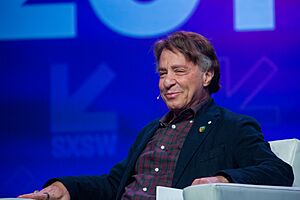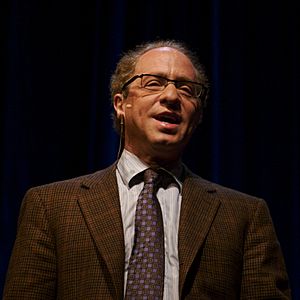Ray Kurzweil facts for kids
Quick facts for kids
Ray Kurzweil
|
|
|---|---|

Kurzweil in 2017
|
|
| Born |
Raymond Kurzweil
February 12, 1948 Queens, New York City, U.S.
|
| Education | Massachusetts Institute of Technology (BS) |
| Occupation |
|
| Employer | |
| Known for |
|
| Children | 2; including Amy Kurzweil |
| Awards |
|
Raymond Kurzweil (born February 12, 1948) is an American inventor, author, and computer scientist. He is also a futurist, which means he studies and predicts what the future might be like. Kurzweil is famous for his inventions that help people, especially in fields like optical character recognition (OCR), where computers learn to read text. He also developed technology for text-to-speech, which allows computers to talk, and advanced electronic keyboard instruments.
Kurzweil has written many books about artificial intelligence (AI), health, and how technology will change human life. He is a strong believer in transhumanism, the idea that humans can use technology to improve their abilities. He often gives talks about his positive views on how things like nanotechnology and robotics will shape our future.
For his work, Kurzweil has received many awards. In 1999, President Bill Clinton gave him the National Medal of Technology and Innovation, the highest technology honor in the United States. He has also been honored by two other U.S. presidents and was added to the National Inventors Hall of Fame in 2002. Many people consider him one of the most important inventors of our time, even calling him "Edison's rightful heir."
Contents
Life and Inventions
A Young Inventor
Ray Kurzweil grew up in Queens, New York City. From a very young age, he knew he wanted to be an inventor. As a boy, he loved reading science fiction and collected old electronic gadgets from neighbors to build new things. By age 12, he was already working with computers.
When he was 15, he wrote his first computer program. This program could analyze music by famous composers and then create its own new songs in a similar style. In 1965, he even appeared on a TV show called I've Got a Secret to play a piano piece that his computer had composed. For this invention, he won first prize in the International Science Fair. President Lyndon B. Johnson personally congratulated him at a White House ceremony.
Creating Helpful Technology
Kurzweil attended the Massachusetts Institute of Technology (MIT). In 1974, he started a company called Kurzweil Computer Products. There, he led the team that created the first OCR system that could read text in almost any font. Before this, scanners could only read a few specific fonts.
He decided the best use for this technology would be a reading machine for the blind. This machine would scan a book and read the words aloud. To make it work, he needed a flatbed scanner and a text-to-speech synthesizer. On January 13, 1976, the Kurzweil Reading Machine was introduced. The famous musician Stevie Wonder, who is blind, heard about the machine and became its first user. This started a long friendship between him and Kurzweil.
Music and Speech Technology
In 1982, after talking with Stevie Wonder about the limits of electronic instruments, Kurzweil was inspired to create a better synthesizer. He founded Kurzweil Music Systems and, in 1984, released the Kurzweil K250. This keyboard could perfectly imitate the sounds of real instruments like a grand piano. It allowed a single musician to compose and play music that sounded like a full orchestra.
He also started a company to develop computer speech recognition systems. His products were some of the first that could understand and respond to human speech.
Working at Google and Looking to the Future

In December 2012, Kurzweil was hired by Google to work on new projects involving machine learning and language. Google co-founder Larry Page hired him personally. Their goal was simple: "to bring natural language understanding to Google."
Kurzweil has also made plans for his own future. He is a member of the Alcor Life Extension Foundation, a company that specializes in cryonics. This means that after he passes away, he plans to have his body preserved at a very low temperature. He hopes that future medical technology might one day be able to revive him.
His Ideas About the Future
The Law of Accelerating Returns
One of Kurzweil's most famous ideas is the "Law of Accelerating Returns." He says that technology doesn't just improve—it improves at a faster and faster rate. This is similar to Moore's law, which observed that computers get twice as powerful about every two years. Kurzweil believes this rapid growth applies to many areas, including genetics, nanotechnology, and robotics.
This leads to his idea of the technological singularity. This is a point in the future where technological growth becomes so fast that it changes human civilization forever.
Health and Aging
Kurzweil believes that future medical technology will allow people to live much longer, maybe even forever. He takes his own health very seriously. He follows a special diet and takes many daily supplements to "reprogram" his body's chemistry and slow down aging.
He predicts that within the next decade, medical technology will advance so quickly that for every year that passes, science will be able to add more than a year to our life expectancy.
His Predictions
Kurzweil has made many predictions about the future. In his 1990 book, The Age of Intelligent Machines, he predicted that a computer would beat the world's best chess player by the year 2000. In 1997, the computer Deep Blue defeated world champion Garry Kasparov. He also predicted the huge growth of the internet when it was still small and hard to use.
Of course, not all of his predictions have been perfect. Some critics point out that things he predicted for 2009, like self-driving cars on highways, did not happen on that timeline. However, Kurzweil claims that about 86% of his predictions have been correct or mostly correct.
Some of his future predictions include:
- By 2029, a computer will be able to pass the Turing test, meaning it can think and communicate so much like a human that it's hard to tell the difference.
- In the future, humans will become a hybrid of biological and non-biological intelligence, using tiny robots called nanobots to fight diseases and improve our brains.
- Solar power will become cheap and powerful enough to meet all of humanity's energy needs.
His Books
Kurzweil has written several important books to share his ideas:
- The Age of Intelligent Machines (1990): This book looks at the history of AI and predicts how it will develop.
- The Age of Spiritual Machines (1999): This book goes deeper into his theories about the future, especially how humans and machines might merge.
- The Singularity Is Near (2005): This is his most famous book. It explains the idea of the technological singularity and what it could mean for humanity.
- How to Create a Mind (2012): In this book, he explains his theory of how the human brain works and how we could build an artificial brain.
- The Singularity Is Nearer: When We Merge with AI (2024): His latest book provides an update on his predictions and ideas about the future of AI.
Awards and Honors
Kurzweil has received many awards for his work. Some of the most notable include:
- The Grace Murray Hopper Award in 1978 for his invention of the Kurzweil Reading Machine.
- The National Medal of Technology in 1999, presented by President Bill Clinton.
- The Lemelson-MIT Prize in 2001, which came with a $500,000 award.
- Induction into the National Inventors Hall of Fame in 2002.
- A Technical Grammy Award in 2015 for his invention of the Kurzweil K250 synthesizer.
- He has also received 20 honorary doctorates from universities around the world.
See also
 In Spanish: Raymond Kurzweil para niños
In Spanish: Raymond Kurzweil para niños
- Paradigm shift
- Simulated reality

